Best Practices For Dialysis Waste Disposal

Dialysis centers, like all healthcare facilities, face the challenges of proper waste disposal. From classification, storing, packaging, and final disposal, dialysis providers are responsible for ensuring that potentially hazardous medical waste is correctly and safely disposed of.
Between sharps, liquid wastes, contaminated PPE, and other medical wastes, dialysis centers have to deal with a lot of waste that requires correct classification and disposal to avoid potential penalties and fines. Here are some of the best practices for dialysis centers to consider for the disposal of medical waste.
TOPICS WE WILL COVER:
1 / What Waste Streams Are Typically Handled in Dialysis Centers?
2 / What Container Types Are Needed for Those Waste Streams?
3 / Why Are Our Solutions Superior for Clinicians and Healthcare Professionals
4 / Why Are Our Solutions Better for Patients?
What Waste Streams Are Typically Handled in Dialysis Centers?
Dialysis centers produce a wide range of waste, some of which are unique from other medical facilities. However, just like any other type of healthcare facility, it is crucial to understand and correctly classify the different types of medical waste produced for proper disposal.
This is not only a must to comply with state and federal disposal requirements but a crucial way to minimize expensive disposal of certain wastes, which could be handled with less stringent requirements through proper classification. Here are the most common types of waste that dialysis centers will face.
Sharps Waste
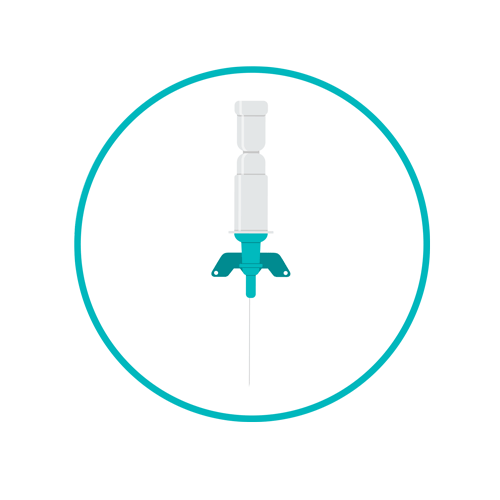
Dialysis providers require a considerable number of sharps, such as IV tubing and needles, among many others. Sharps waste is particularly harmful to the safety of both staff and clients due to the risk of needlestick injuries, which can transmit potentially fatal diseases and infections.
In order to minimize this risk, it is crucial to store sharps waste in secure, puncture and leak-resistant containers. Medical facilities need to handle this waste appropriately through an approved medical waste disposal provider to ensure safe and responsible handling.
Biohazardous Waste
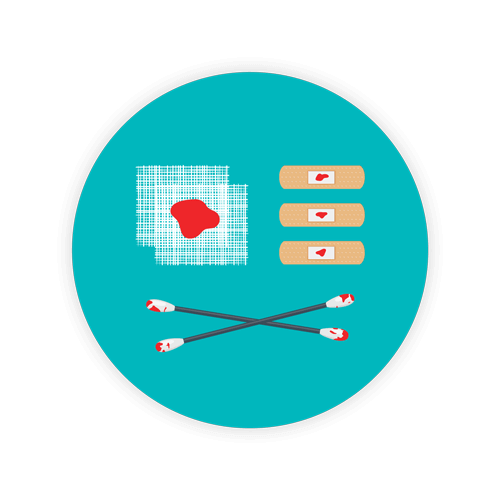
Another type of waste that dialysis centers will invariably handle is biohazardous medical waste (also known as regulated medical waste), which includes any materials that may have been contaminated with infectious agents, such as blood or other bodily fluids. Due to the fact that the dialysis process involves the filtration of blood through hemodialysis, it inevitably produces biohazardous waste. This waste poses a significant threat of transmitting disease and infection if individuals are exposed to it. As a result, facilities must handle this waste properly to prevent the risk of exposure and resulting liabilities.
Pharmaceutical Waste
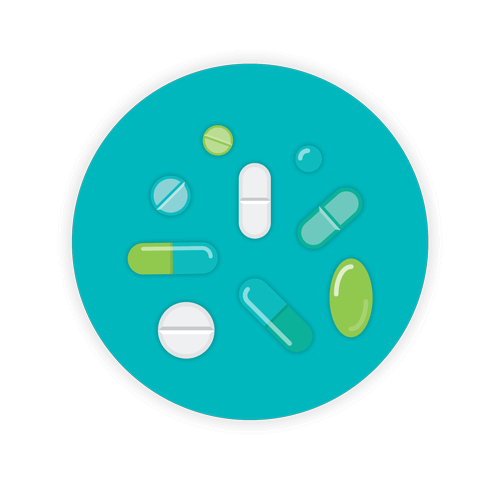
Dialysis centers often carry a variety of medications intended to assist with the dialysis process. Often these medications include Erythropoietin, Darbepoetin, and iron supplements, among others. These medications are crucial for the health of dialysis patients and for ensuring an effective procedure. However, when they either become expired or contaminated, they will need to be disposed of correctly to prevent harm and misuse. This requires a specific secure storage and disposal method.
What Container Types Are Needed for Those Waste Streams?
Just as with every medical facility, dialysis centers require unique containers to store each of these types of medical waste. These containers each have unique properties to ensure safe and secure disposal, and here is a quick breakdown of each one.
Sharps Containment
Sharps present a unique challenge to contain by their very nature. Needles and other sharps can puncture many types of containers, transmitting contamination and causing injury to those handling them. As a result, containers must be durable and puncture resistant while sealing in any hazardous contaminants.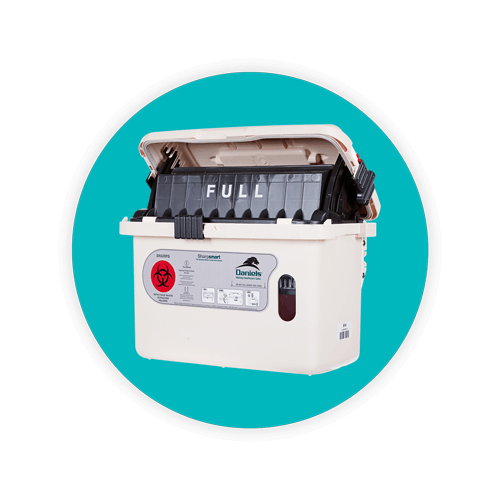
This means that a truly secure containment method like Daniels’ Sharpsmart should be used. The Sharpsmart offers thick puncture-resistant containment that prevents leaks. Its advanced safety features include anti-tamper mechanisms that seal contents in and prevent unauthorized access. Additionally, they are designed to minimize touches and can be placed as close to the point of use as possible, minimizing needlestick injury risks.
Biohazardous Containment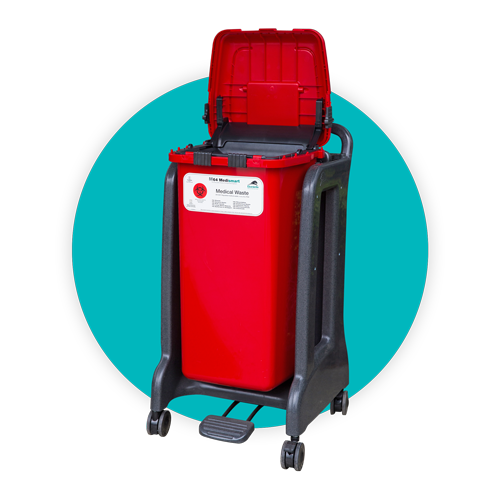
Biohazardous waste, or “red bag waste” as it is often known in the US, contains potentially infectious material in both liquid and solid forms. As a result, this waste requires a container that prevents spillage, leakage, and cross-contamination from occurring.
Daniels’ Medismart offers this type of high-quality containment that takes the red bag out of biohazardous waste. Then, in its place, Daniels offers secure, reusable, touchless hands-free containment. The Medismart’s touchless disposal reduces the risk of cross-contamination, and its permanent safety lock reduces the potential for leaks and spills. Much like our other container solutions, it is meant to be placed at the point of use to avoid unnecessary handling of waste.
Pharmaceutical Containment
Expired or contaminated pharmaceuticals pose the unique threat of tampering or misappropriation and, as a result, require secure disposal from the cradle to the grave. This need for security requires a durable tamper-proof containment medication that prevents unauthorized access.
Daniels’ Pharmasmart container provides a tamperproof design with built-in overfill protection for non-hazardous pharmaceutical disposal. These secure containers work as part of a system in combination with secure pickup and disposal that is monitored from start to finish. This includes all necessary reporting to comply with federal and state requirements for disposal.
Why Are Our Solutions Superior for Clinicians and Healthcare Professionals?
Daniels’ reusable containers offer the best solution for dialysis centers. Safety is the top priority at any stage in the dialysis process, and that includes the waste disposal stages. Daniels’ reusable medical waste containers are designed to meet the highest standards of safety and ease. Sharpsmart handily reduces the risk of sharps injuries versus other containers by simplifying the disposal process. Medismart prevents spillage and leakage of hazardous waste more effectively than competitors, and Pharmasmart’s securely-locking pharmaceutical waste containers will prevent misuse or abuse.
One of the most important functions of medical waste containers is not just keeping trash in but keeping others out. Medical waste, from sharps to medications, can never be safely retrieved or reused, and Daniels Health’s disposal units are designed to prevent unauthorized access, with durable locking mechanisms and built-in anti-tampering features. Staff and patients will be prevented from accidentally exposing themselves to dangerous waste forms.
Additionally, with a clarified medical waste segregation policy, total waste costs can decrease by avoiding unnecessary overclassification of waste. With clear differentiation of waste containers and resources like training posters, we can help to ensure that your staff’s lunch, for example, is not finding its way into a biohazardous waste container.
Finally, clinic workers want to build a great impression of their facility at all times, especially in busy client-facing areas. Stopping to handle waste needs slows down the care of patients and gets in the way of other crucial tasks. A streamlined waste disposal system with clearly-marked, error-proof, safe containers allows them to focus on patient care and (almost) forget about waste disposal.
Why Are Our Solutions Better for Patients?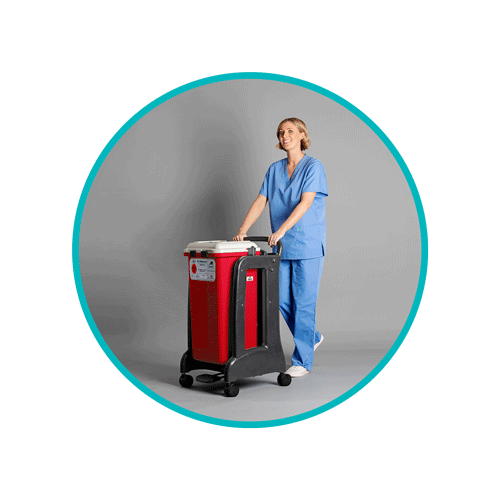
Medical waste is not pleasing to look at, and neither are most medical waste container methods. Patients receiving dialysis treatment do not need a reminder of their condition and certainly do not want to look at traditional industrial
containment methods. They certainly don’t ever want to see the contents of medical waste. Daniels reusable containers offer an aesthetically pleasing alternative to other containers.
Sourcing visually-discreet containers improves the spatial environment of a clinic. It also contributes to a calmer, more soothing space for treatment to occur. Daniels’ containers leave medical waste out of sight and out of mind for patients–as it should be.
This also means patients never want to see their care providers struggle to properly dispose of waste. Eliminating trash should be a simple and fast process that appears effortless, strengthening their faith in their caretakers instead of testing it. Daniels’ containers offer a clear delineation of different classifications of waste and fast servicing whenever it is needed, which helps make disposal easier. This means more time for treatment providers to do what they do best: helping patients. If clinic workers don’t need to think about waste, patients won’t, either.
